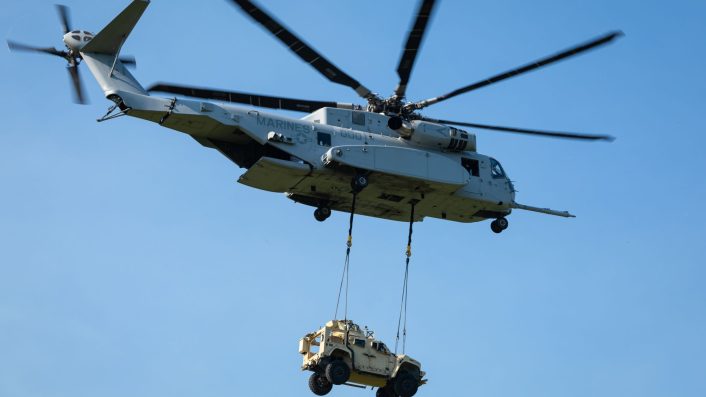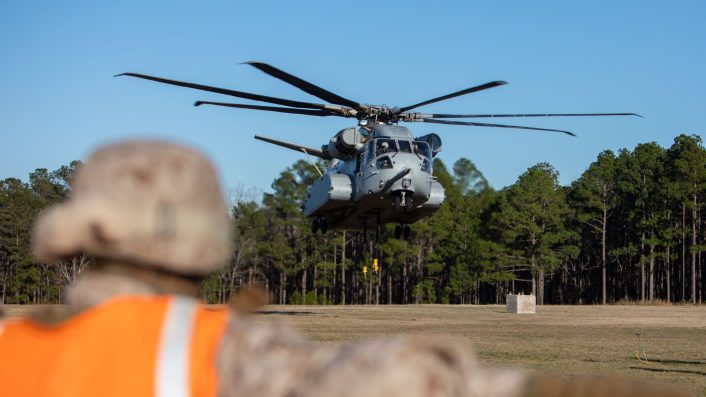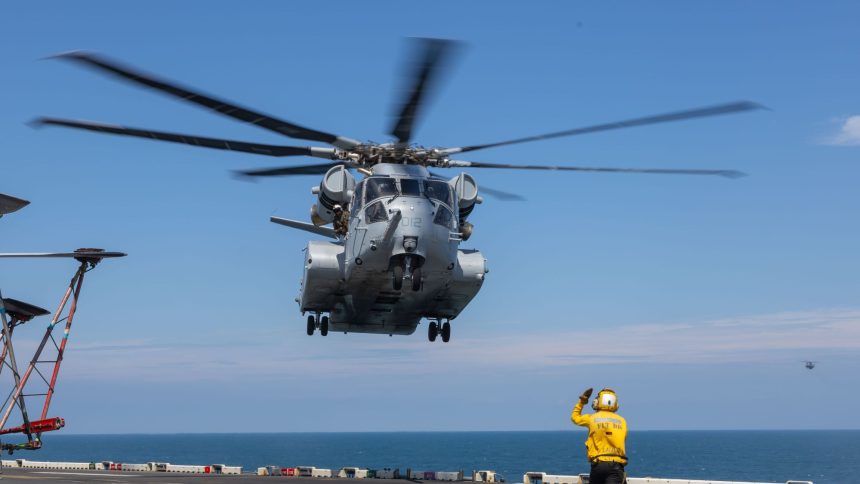This $10 billion order is the biggest to date for the CH-53K, of which the Marine Corps plans to procure 200 airframes.
Sikorsky announced on Sep. 26, 2025 the award of a $10.8 billion contract from the U.S. Navy to build up to 99 CH-53K King Stallion helicopters for the U.S. Marine Corps over the next five years. The order, which covers five contracts from Lots 9 to 13 over five years, is the “largest-quantity order to date for the aircraft” which will “ensure consistent deliveries” of the helicopter between 2029 and 2034, the press release said.
Of the Corps’ plan to procure 200 CH-53K King Stallions, Sikorsky says it has so far delivered 20 helicopters, and an additional 63 aircraft are in various stages of production, part of Lots 4 to 8. As for the older and troubled CH-53E Super Stallion, the Marine Aviation Plan 2025 puts its current inventory at 127 aircraft, which is “approximately 30 aircraft short of the Echo’s lifecycle aircraft requirement.”
The CH-53K King Stallion is the largest single-main-rotor helicopter in the U.S. military arsenal. The CH-53K entered Full Rate Production in December 2022, eight months after the Corps declared IOC (Initial Operational Capability) in April 2022, when the Marine Heavy Helicopter Squadron 461 (HMH-461) became the first to induct the type on Jan. 21, 2022 at MCAS New River, North Carolina.
The CH-53K is essential to the Marine Corps mission – transporting troops, supplies and heavy equipment across a contested battlefield. Over the next five years, we’ll build and deliver up to 99 more helicopters to meet this critical need.
— Sikorsky (@Sikorsky) September 26, 2025
CH-53K King Stallion’s Future in the Marine Corps
The CH-53K King Stallion is the mainstay of the Corps’ heavy lift capability, transporting both troops and heavy equipment, like JLTVs (Joint Light Tactical Vehicles), 420E backhoe loader earthmovers, inflatable boats and even F-35s during slingload operations. Those operations are conducted by the Marine Logistics Battalions, under the Marine Logistics Regiments within the broader Marine Logistics Groups.
The U.S. Marine Corps began a phased transition from the CH-53E King Stallion to the CH-53K Super Stallion in 2019-2020 for all its six heavy lift squadrons operating at least 16 helicopters. This process will continue well into the 2030s. Specifically, as per the latest Marine Aviation Plan 2025, the CH-53K King Stallion is expected to fully replace the CH-53E Super Stallion by FY32.
Speaking at the Helicopter Technology Central and Eastern Europe conference on May 22, PMA-261’s Maj. Joshua Banks said that no squadron will simultaneously operate the CH-53E and ‘K’ variants, and a unit undergoing conversion will not deploy during that period.

The Sikorsky press release quoted Col. Kate Fleeger, Program Manager for the H-53 Heavy Lift Helicopter Program Office (PMA-261), who explained how the large contract helps “achieve better pricing” as Sikorsky can “bundle purchase orders from suppliers […] and pass the savings on to the government.” The order aids “dependable delivery to the fleet and a consistent and predictable timeline for the transition from the CH-53E to the CH-53K,” Fleeger said.
Sikorsky also noted the CH-53K King Stallion’s order’s importance for the U.S. defense industrial base, as it sustains “thousands of production roles at Sikorsky and across its nationwide supply chain.” The CH-53K sources parts from 267 suppliers across 37 states in the U.S. and 17 international vendors, according to available information.
Rich Benton, Sikorsky Vice President and General Manager said: “The multi-year contract enables Sikorsky to partner with the Department of the Navy to drive long-term affordability, optimize production efficiencies and stabilize our supply chain and workforce, ensuring the Marines maintain the strategic advantage with the CH-53K in a rapidly evolving battlespace.”
A #MarineCorps CH-53K King Stallion helicopter assigned to Marine Heavy Helicopter Squadron (HMH) 461 lifts a Joint Light Tactical Vehicle assigned to Combat Logistics Battalion 22 (CLB-22) during a helicopter support team exercise on @camp_lejeune.
CLB-22 and HMH-461 took part… pic.twitter.com/agxWgRy1SM
— U.S. Marines (@USMC) September 17, 2025
Improvements over the CH-53E Super Stallion
The King Stallion features a full-glass cockpit and digital-fly-by-wire flight control system, easing pilot workload; three General Electric T408 turbofans, generating 50% more power; an all-new transmission and rotor assembly; redesigned gearboxes, correcting the design flaws in the ones on the Super Stallion; improved, more efficient blades; and 63% fewer parts than than the CH-53E.
The Corps says the CH-53K King Stallion offers “three times the range and payload capacity” of the CH-53E Super Stallion, to “transport heavy equipment, troops, and supplies over long distances, ensuring forces remain agile and supported.”
The CH-53K is currently cleared to conduct a 27,000-pound external lift and is projected to be cleared for a 36,000-pound external lift under high, hot conditions, nearly thrice than its notoriously problem-ridden CH-53E Super Stallion.

Recent Sling Load Operations
On Aug. 27, 2025, a CH-53K King Stallion from the HMH 461 transported the first F-35B (Short Take-Off Vertical Landing) that was built – airframe BF-01, and which performed the type’s first vertical take off and landing – as a sling load from NAS (Naval Air Station) Patuxent River to MCAS (Marine Corps Air Station) Beaufort in a 552 mile (888 km) journey. The aircraft was retired as a static display there.
Before that, on Dec. 13, 2022, a King Stallion conducted its first “external load certification testing lift” at NAS Patuxent River by carrying a non-flyable F-35C, CF-1, “to evaluate the load and inform future lift capabilities,” and generate data from the “sling configuration analysis and cargo characteristics.”
Then, on Apr. 24, 2024, CF-1 was again lifted by a CH-53K King Stallion from VMX-1 from Pax River ITF to the NAWCAD’s PMT (Prototype, Manufacturing and Test) facility at Joint Base McGuire-Dix-Lakehurst, New Jersey. The CH-53K was also refueled mid-flight by a KC-130T with the F-35C (CF-1) suspended underneath.
#Marines with Marine Aircraft Group 29, 2nd Marine Aircraft Wing, transport an F-35B Lightning II near Naval Air Station Patuxent River, Maryland.
The F-35, known as BF-1, was the first F-35 to perform a vertical landing and was transported to Marine Corps Air Station Beaufort,… pic.twitter.com/zDHwq364yy
— U.S. Marines (@USMC) August 28, 2025
It can flexibly operate from both “land and sea bases, including austere sites and amphibious shipping,” ferrying both “internal and external cargo loads, maintaining performance in degraded environments,” giving the MAGTF (Marine Air-Ground Task Force) significant heavy tactical mobility. “This versatility allows it to execute complex missions like combat assault transport, casualty evacuation, and logistical resupply, maintaining the MAGTF’s operational tempo and effectiveness,” the Corps added in the plan.









